|
Posted by Ronnie on
12-26-2006
|
This seems like an appropriate place to share my latest thoughts about Macondo copying!
I thought I built almost copies of the Macondo upperbass horns, yet I've really only achieved quite questionable results. Impressive from time to time, but never free from gross problems.
I even had a dream where Romy was in the neighbourhood but refused to listen to these problematic horns:
-"Absolutely not! Start with a table radio instead, and identify the problems with the sound."
Hahaha! Frustrating, but perhaps it made sense.
Today I'm listening to a pair of bookshelf speakers.
They weren't quite useable stock, but with ports plugged, bass rolled off at line-level and a little bass tower on each side: Wonderful! Much closer to my "headphones ideal".
The horns will do duty as turntable stands, strange art or immovable stools for a while. It's all good. :-)
|
|
|
|
Posted by Romy the Cat on
12-26-2006
|
I moved your post into a separate thread as I think your post about a subject, contrary to the thread where it was moved from was about the virgin fantasies…  Ronnie wrote: Ronnie wrote: | | I thought I built almost copies of the Macondo upperbass horns, yet I've really only achieved quite questionable results. Impressive from time to time, but never free from gross problems. |
|
I never liked an idea of copying loudspeakers. There is a community of people why build copies of famous loudspeakers but if you talk with the most advanced among them they admit to you that it is simple to copy design but it very difficult to copy Sound. You see, loudspeakers are like violins, there are so many minute things that affect everything that it virtually imposable to get identical sound. Take for instance the Tannoy GRF – what could be more simple then that? Screw in a driver and use a simple enclosure that any carpenter would cook for a day… But it never so simple and if you are familiar with the subject t that you know that as many of them out there as many different Sounds they have. I would not be in position to enumerate all reasons that would make them to sound different: too many of them but the fact reminds the same: identical drivers, identical designs but different sounds… Another example, everyone know Bruce Edgar who builds horns but not a lot of people know that Bruce never was able to make two identically sounding pairs of upperbass horns (it is not my observation but the observation of very credible (from my perspective person) who very familiar with very many of Bruce installations)…
I think instead of coping loudspeakers it would be more appropriate to consider embracing and re-utilization some design ides. For this prospective there is nothing to “copy” in the Macondo upperbass horns. The horn is a very standard tractrix horn with 4” throat. If you forget about Macondo and calculate own profile then you will end up with the identical horn. All the rest are juts specific implementations and up to my knowledge only one person besides me copied the Macondo upperbass horns, it and he is here, in Boston. I do not know what kind results you achieved and what methods you used but if you call the results questionable then you perhaps might be more specific and I might try to help you to debug the problem/s. Put down you observations about the sound of just one upperbass horns, without any other channels, with no crossover and with a back chamber wide open… Post pictures and if it poosble the frequency sweep. It would be a good to start… so far you do not say that Macondo upperbass horn has questionable results but that a 4” into 115H straight Tractrix horn loaded with Fane Studio 8 has questionable result. I would like to stay behind of me statement that the above mentioned configuration should not be problematic. If you feel it is then let find together what might be wrong.
Rgs,
The Cat
|
|
|
|
Posted by Ronnie on
01-04-2007
|
 Oh well.. I'd really like to save the horns. I appreciate your offer to help out! Oh well.. I'd really like to save the horns. I appreciate your offer to help out!
Still no measurements, but this can start the trouble shooting...
CONSTRUCTION
First I refreshed my memory of exactly what I built. They certainly are far from being copies.
I cut the horn where the throat dia is 5.6" instead of 4".
The idea was to extend it (6 inches) to make the throat 4" only if it didn't turn out well. I hadn't expected such big problems with the sound though.
Exact details are in this post: http://www.goodsoundclub.com/TreeItem.aspx?PostID=1807#1807
PROBLEM
It sounds like hard clipping on tones around 1kHz or something.
Even my camera microphone catches it easily.
Listen in headphones and compare the first two tones with the rest: http://www.webbtjanst.se/temp/horn_piano.avi
The two distorting tones are repeated at the beginning of each bar.
It's only the right horn that's playing, without back chamber.
Some photos.
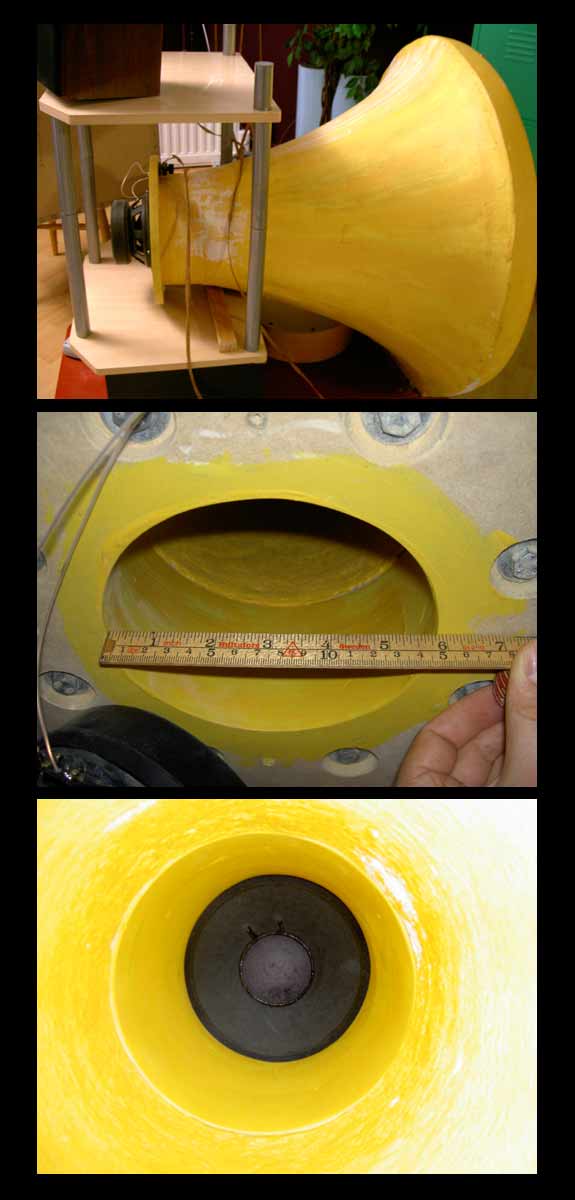
The beginning of the throat is little wider than planned, but only for the first millimeters.
|
|
|
|
Posted by Romy the Cat on
01-05-2007
|
|
Ronnie,
I’m sorry I was not able to detect the clipping you were taking about listening your file. However, if you can hear ANYTHING distorted at 1kHz (when ONLY your upper bass horn is playing) then you might consider the following: it has NOTHING to do with horn at this frequency.
1) The driver might be defective (do both change have the distortions? Do distortion take place when the driver is not loaded into the horns)
2) The driver’s outer suspension touches the mounting plat of the horn during the driver operation. (Put a few mm gasket between the driver and the horn and see if the distortions went away? Alternatively you might wet the back pane, then attach the driver, play it and then see if the outer suspension got moisturized)
3) There is some dirt in the front chamber that “rings” at 1kHz. (Disconcert driver and clean it up, use vacuum cleaner)
What crossover frequencies you use ay your channel?
Ronnie, I’m very confident that your “1kHz problem” is a pure mechanical accident and it has nothing to do with the initial design. I am sure that soon on later you will find what the problem was. However, there is something that makes me concern about your horn much more then the “1kHz syndrome”.
You see in the horns everything is connected….
I am concerned that in the horn you made sound might have compressed and suffocated …. and it would come directly form the horn design. I am not convinced (I never head the thing) in what I proposed and you should be the judge but let me to explain my rational to propose what I’m proposing
When I advocated use of Fane8M driver I meant that the driver does good job loaded into my 4” horn. Now, Fane8M is 150Hz-400Hz driver and at its bottom knee the 150Hz is kind of “pushing”. When we place a driver into a horn then the horn provide low frequency equalization. At open air the Fane8M roles at 300Hz-500hz (I do not remember correctly the numbers – I did it 6-7 years ago), in sealed box it goes down to 90H-120Hz. Surely, we do not want a MF driver to stress to the bottom of it’s capacity, and particularly those low-excursion drivers. So, if you listen the Fane8M in a sealed box then it would sounds fine at 700Hz but it will sound compassed at 100Hz….
Then we load the Fane8M into a horn. A horn equalizes low frequency up, the type horn that you and I use does + 6dB at it bottom. The key in here is to understand at WHICH FREQUENCY those + 6dB will occur. The lowest threshold of the equalization determined by… the diameter of the throat - the smaller throat the stronger equalization at lower frequency. Now, let pretend that we have the identical deriver that sits in 4” throat ands in 6” throat (let disregard the back chambers). The 4” will make a 300hz-in-air driver to have +6dB at 120Hz but the very same driver that mounted into 6” throat will do +6dB at 180Hz. (All numbers are for the sake of illustrations). So, in order to make the same drivers into the different horns to sound 120Hz at 0dB the different horns/drivers should be driven with the different level of hardness. Interesting that in case of 4” horn the 120Hz at 0dB will be coming NOT FROM THE DRIVER EXCURSION (it not mass-centric but velocity centric system) but from the “artificial” horn’s equalization (in this case the word “artificial” is positive). However, in the case of the 6” driver the 120Hz at 0dB will be produced by EXCURSION OF THE DRIVER + “some residue of the horn EQ. Nevertheless, let do not forget that our driver might not sound as good when it stressed to operate too low. I would not even mention that fact the in this “EXCURSION” situation the driver is still sitting in a horn but in fact it acts as a direct radiator (there many other problems in this setting like Doppler distortions, “modulative boom” and so on)
This is why I generally advocate smaller throats… for a given driver. The Fane8M is fine with 4” throat, 115-120Hz but I feel that it very maximum that is possible to get out of this driver. I get in my smallish room 100Hz by back-chambering the driver and by picking some room gain (although the horns are in middle of the rooms). You have open back (which it fine). Your have the horns sitting in the middle of the rooms (where they should be) but it looks like your room is relatively large room. So, you might loose 10-15Hz in back chamber and I would say 10-15Hz in the room. Then you might be loosing 30-40Hz because the 6” throat. Yes the driver still might make the 115Hz but it made but driving the driver harder and by use of the DRIVER EXCURSION INSTEAD OF THE HORN EQUALIZATION. This is the key to understand why the larger mouth makes horn idea not as worthy as it could be. In fact… if you drive the horn harder then you might have excessive lower MF that you would need to kill by filter…
So, I do not know if in your configuration with 5.5” throat the Fane8M was an optimism driver. I never used it this way but looking what the driver does in open air and sealed box I have my suspicions and it might act as the “oxygen deficient driver”. In fact, even in my 4” horn I might recognize the first signs of the ““oxygen deficiency” but I still was not able to fine better driver tonally with 1003dB sensitivity. If I were you I would try some other 8”-10” drivers that might go slightly lower then Fane8M, I would say for 10-20Hz lover. Do not forget that you with your horn will be using this driver at it’s very bottom with a great influence of the “direct radiation operation style”. The alterative version, if you LF section can handle a higher crossover point would be to high-pass your horn at 140-150Hz (where it still might act as 100% horns) and to listened if it sound better.
Ronnie, this all are juts my speculations and you feel free to regard them if you do not see any auditable avoidances of what I said. Rgs,
Romy the Cat
PS; Ronnie, since I moved your post into a separate thread I took liberty to rename your moved post since it became the subject of the entier thread. (Tt was “Coping loudspeakers for Cats”). I hope you do not mind
|
|
|
|
Posted by Ronnie on
02-08-2007
|
I put together a hot tube amp channel, and gone is the sound of shattered glass.
All three of my receivers were distorting equally horribly.
Beware of never-been-serviced vintage solid state, I guess!
Anyone know if it is common for old SS gear to develop clipping-like distortion regardless of power level?
|
|
|
|
Posted by Romy the Cat on
02-08-2007
|
 Ronnie wrote: Ronnie wrote: | I put together a hot tube amp channel, and gone is the sound of shattered glass.
All three of my receivers were distorting equally horribly.
Beware of never-been-serviced vintage solid state, I guess!
Anyone know if it is common for old SS gear to develop clipping-like distortion regardless of power level? |
|
Ronnie, I very much relieved that you resoled your problem. I kind of felt responsible that someone why read my site, was seduced with my path, invested time and efforts to near replicate the “accused positive results” and then end up with a failure.
Frankly speaking when I was pulling out of my ass the VERY MINUTE reasons why your horn might not sound well I was implying that those reason my affect no more then 2%-3% of total horn performance. Still you reported a catastrophic failure… I was blaming a defective driver (that I did not believed) but I even in my sickest imagination was not able to foresee what you drive the thing with faulty amp. In fact with 109dB sensitively I was under impression that you drive your upper bass channel with the same amp as your MF channel…
Still, even if I knew that you use very poor amps I would hardly anticipate that it should be as bad as you descried.
I did not use with my horns any receivers but I used a number of different good and bad SS amplifiers. Generally I deduced that SS amplification must not be use with alnico drivers but with ceramic drivers very selective group of SS amplifiers did work near acceptable (Lamm M1.1 for instance). I do not know what happen in your case. You say that you used vintage solid state receivers. They are notoriously bad generally. In additions they made to work “economically” and made to switch right into class “B” after developing a few fraction of watt. A horn must not be driven by class “B” - very bas for sound. With horn you need ONLY class “A” and only “A1”. With other speakers the problems outside “A1” might be masked out by the dullness of the speakers, not with horn. With a very good driver and a properly designed horn (and it is what you have) all sonic problems of class “B” are right in your face. BTW, a fraction of watt it is exactly how much you take out of amps with 109dB sensitivity. At this level your amps most likely are switching to class “B” and that switching moment is the most disgusting in amplifier. Still, “that” sound should be AS BAD as you described but it is another story…
Anyhow, regardless of the reasons you should be absolutely crazy to try the driver the level of Fane 8M with a cheap SS receiver. Try to drive your upperbass horn with your MF amp…
Rgs,
Romy the caT
|
|
|
|
Posted by Ronnie on
02-08-2007
|
"Still, even if I knew that you use very poor amps I would hardly anticipate that it should be as bad as you descried"
-I could imagine one of them being faulty to this degree but not all three, and not at ALL sound levels!
Those amps really drove me nuts.
Picture someone trying to squeeze good sound out of speakers using a slightly chopped-off signal!
Perhaps it was good practice in some Karate Kid kind of way. ;-)
Now I'm sure longing for the 6 OPTs I ordered in April!
|
|
|
|
Posted by Romy the Cat on
02-09-2007
|
 Ronnie wrote: Ronnie wrote: | "Still, even if I knew that you use very poor amps I would hardly anticipate that it should be as bad as you descried"
-I could imagine one of them being faulty to this degree but not all three, and not at ALL sound levels!
Those amps really drove me nuts.
Picture someone trying to squeeze good sound out of speakers using a slightly chopped-off signal!
Perhaps it was good practice in some Karate Kid kind of way. ;-)
Now I'm sure longing for the 6 OPTs I ordered in April! |
|
Ronnie,
The Fane8M driver are highly inductive load, still you should not have problems to the degree that you described. A SS PP A/B should have a lot of compression on your horns, shell has practically no colors on your horn, but it should not distort. If I had the same problems with distortions, the problems that rise to the point of being “alien sounds” then I would run the channel from a generator’s sweep to see what kind resonances or any other defects the driver might have. In fact I run of generator sweep all my drives, and particularly the compression drivers, to see initially what they do.
Anyhow, I have no problems you make a little blinder, it is perfectly fine, we all do them but what I do have problem with your purely methodological inaccuracy. If you remember I was keep asking you how the horn sounded driven full-range from a single amplifier without anything else attached. Are you saying that over the course of a few month (!!!) you never connected your upperbass horn (that has the same sensitivity as you MF driver) to your MF amplifiers? How would it be possible?
Hold on, hold on… would it mean that your use the same type SS receiver for MF channels as well? If so, then you never experienced your horns at all. It is ABSOLUTELY PROHIBITIVE to drive 109dB sensitive installation with SS A/B amplification. A high sensitively speakers are VERY different way of dealing with amplifiers…. Rgs,
Romy the caT
|
|
|
|
Posted by Ronnie on
02-09-2007
|
"would it mean that your use the same type SS receiver for MF channels as well?"
-Da! I'll do better. :-)
I think my Fostex MF horns ought to be below 100dB sensitive though.
"The Fane8M driver are highly inductive load, still you should not have problems to the degree that you described."
-I'll investigate further when I have output transformers that match the Fanes impedance. The new amp sure didn't fix all problems right away.
|
|
|
|
Posted by Romy the Cat on
02-11-2007
|
 Ronnie wrote: Ronnie wrote: | | "would it mean that your use the same type SS receiver for MF channels as well?"<BR><BR>-Da! I'll do better. |
|
Ronnie,
I did not realize that you drive all your horns with those cheap SS receiver. You absolutely must not do it. Just do not use horns if you use those receivers and you will get much better sound. It is not the encourage you to go for better amplification. However you were gullible enough to make the horns and now you violated the basic rules of physics trying to use those horns.
If you are wiling to drive your horns with SS then do not ever think about class B amplification, and for MF horn it is even more devastating then for bass horns. In class B both shoulders are completely off. When the open up there us a time delay and low-level non-linearities that lead to severe distortion. This distortion is worsening with output level going down and ay small signals the Class B amp are frightening. My air-conditioner sounds better then Class B plying “small signals”. Do not forget that with 109dB sensitivity… whatever you do, you are in the domain of ultra low signals, particulary with you HF channels…
The Class A/B is not a lot better if it biased to switch to B class at low power. The switching distortions, the crossover distortions, the distortions because the SS devises operate outside of their maximum linearity regions, some bogus noises and harmonic components and many other problems in A/B makes them unusable with horns.
So, get rid those receivers immediately or if you must use them that bias them as high as possible, as long their design and heat dissipation allows them. You should have at least 5W of pure A1 out your receiver to be able to drive your horns. You still will not get a good sound but you will be further from the absolute misery
Rgs,
Romy the Cat
|
|
|
|
Posted by Ronnie on
08-16-2007
|
I think about 99% of the problems with sound that I've complained about has been about slap echo.
It took a lot to figure out that it could so completely shatter the sound!
As long as there are no flutes or pianos in the music, it isn't that troubling, but for example the Goldberg variations have sounded completely and utterly broken (and still are rather unpleasant to listen to).
Attached is a photo of the room as it looked a week ago.
At the edges you can see the velvety uneven surface of the new "inner walls"; inflatable matresses.
|
|
|
|
Posted by Romy the Cat on
08-16-2007
|
|
Ronnie,
It is very simple to test if the clapping echoes defuse your sound too much. I usually use a method that I call “sailboating”. In fact I use the “sails” permanently installed in my listening room and it is the way how I control certain things that what I what to control…
So, sit in your listing chair and ask your friends to move a “sail” above your head in to the direction of direct line of sight with the first reflection from you speaker. You will instantaneously shell be able detecting if the defusing effect of clapping echoes is gone. BTW, if it exists then it craps sound not only on the flutes or pianos but everywhere….
Now, the biggest question would be – what is the “sail”. A sail is a large peace of fabrics that might have different acoustic density – more thickness, mass and more hair on it the lower range it will be effective. Do not forget - you do not what to crate a perm impediment for sound by sailing-out the reflections. You what to put a sort of acoustical low-pass filter for the first reflections. I used as past as gentle sails as very fine quality silk … it is still auditable.
Of course in each given case the location, size and the acoustic aggressiveness of the sails would be different. Here is how the Sailboating is implemented in my listening room. My sails are approximately 1.5M by 3.5M and they are made from… actually I have no idea what they are made from. They are very fuzzy but very light and transparent… I call it “angry fabrics”….
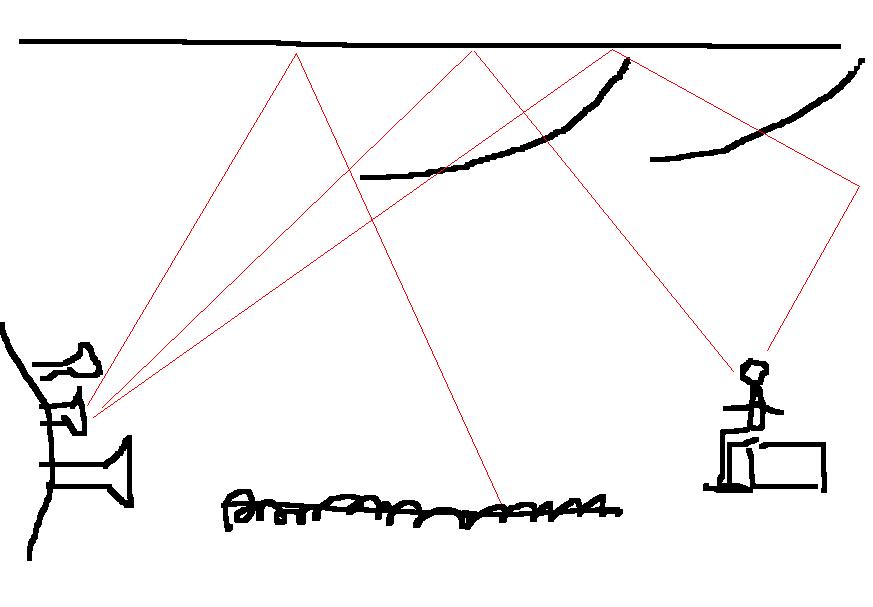
Rgs, Romy the Cat
|
|
|
|
Posted by Ronnie on
08-16-2007
|
The sail ideas sound good, and I did play with it a little (before realizing the magnitude of this rooms acoustic problems).
When you talk about diffusing effects, I think of reflections and reverberation that smears the sound so that it looses focus or contrast. That's bad stuff, but a much smaller problem than what I'm focusing on to begin with.
I have a theory that the contrast shouldn't increase at all when I cup my hands around my ears to block out non-direct-sound. It makes a big difference now. Does that sound right to you?
"you do not what to crate a perm impediment for sound by sailing-out the reflections"
I'm not sure if the rules change here, because my concrete ceiling is only about 205cm above the ground.
That gives me only about 15cm to work with (I want to allow tall people in the room).
What the new soft walls are curing is something that sounds like many percents of odd distortion, and tones appearing from the wrong side of the room or even from different parts of the room at the same time.
It seems to work very well, but I have many more square meters of wall space to cover.
I also have the hard wooden floor to deal with.
|
|
|
|
Posted by Ronnie on
08-23-2007
|
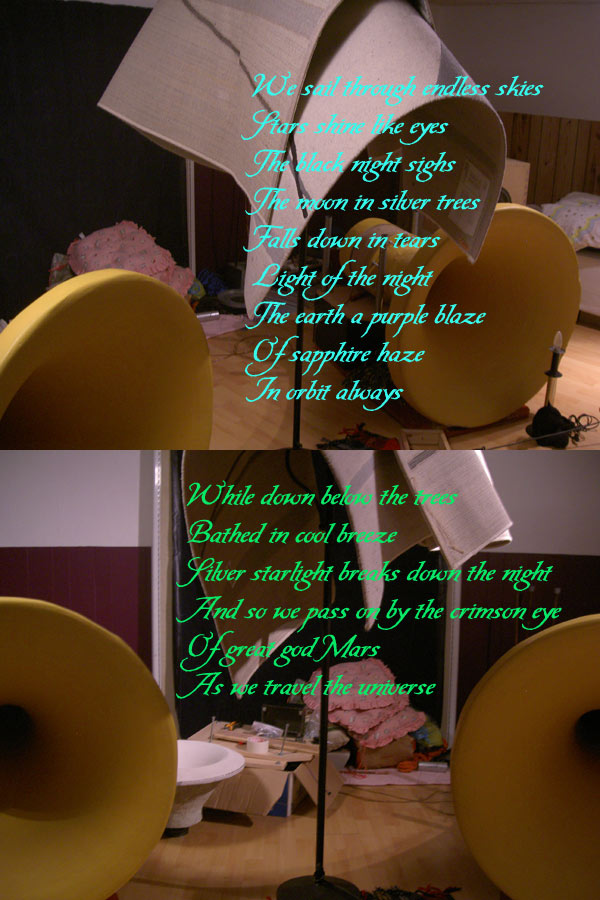
I'm lyrical about the effects of a carpet-on-a-stick..... Much increased calm and reality. A lot more than I could have imagined!
Makes me want to throw a proper ceiling-sailing party right away. :-)
(lyrics: Black Sabbath)
|
|
|
|
Posted by Ronnie on
08-27-2007
|
 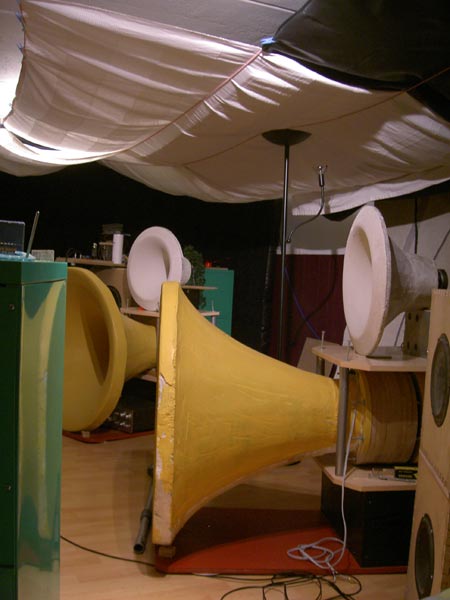
New attempts at ..well... absorbing reflections from the low ceiling (and diffusing the very highest frequencies I suppose). This is not exactly the type of treatment I want, but it works for experimenting.
I also don't think this is quite the same as "sails". I think that this room might have different needs because the ceiling is so very low and hard.
I've put up some matress-like material in the middle, and only thinner cloth outside.
My first attempt, with only a large sheet of thin cloth, seemed to totally kill the treble in the room.
Anyway, these big areas of thin cloth really calms down the presentation. Old treble floating around the room is clearly disturbing.
Yes... I will replace those MF horn sheves one day. Those horns sit at least a few inches too low right now also.
Oh, and folks... as you can see from the photo -don't finish the edges of 100 zillion lbs horns with gypsum. It breaks easily.
|
|
|
|
Posted by Romy the Cat on
08-27-2007
|
|
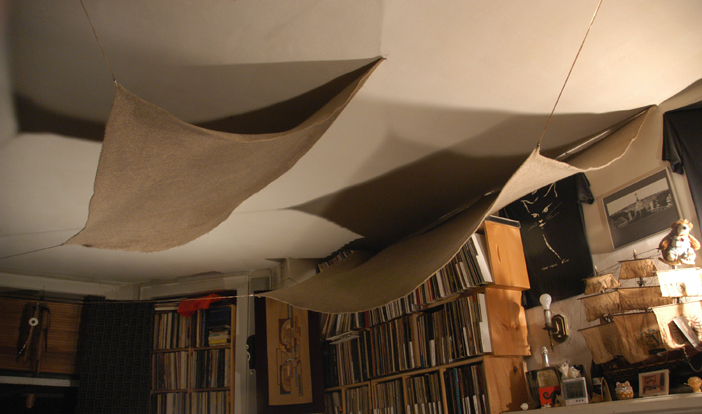
|
|
|
|
Posted by Ronnie on
08-27-2007
|
|
Your boat looks quite tall, and full with records (killing reverberation at mid-to-high frequencies).
I guess those sails are not doing so very much for reverberation at high frequencies as much as blocking disturbing early reflections... or providing some kind of HF randomization? God knows I'm talking out of my hiney now. :-)
BTW, I'd like to pitch a thought I just had that is very much related and equally badly grounded:
-Perhaps the big mouths of our mid bass horns are really blessings in disguise in relation to what is playing above them...
Think about it; they completely block out what would otherwise become early MF reflections from the floor.
I've heard the advice many times to have a table or at least very thick carpet just in front of the listening position to either redirect or absorb these reflections.
Hrm. Enough mindgames for now.
The ceiling treatments have made pianos even less disturbing, but I still have a long way to go with this boat.
|
|
|
|
Posted by Manuel on
08-29-2007
|
interesting solution
how tall is your ceiling?
I´ve been thinking how to solve reflections from a low 7´ ceiling, and have not reached a proper solution
|
|
|
|
Posted by Ronnie on
08-29-2007
|
Manuel: Our ceilings are almost equally low then.
It's not a solution yet though, only some basis for experimenting. It might end up quite different.
|
|
|
|
Posted by Manuel on
08-29-2007
|
|
Ronnie, I´m looking forward your findings
|
|